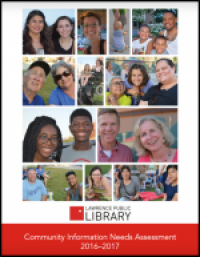The Lawrence Public Library serves a population of 114,967. Located in Northeast Kansas, Lawrence is 45 minutes west of Kansas City, and 30 minutes east of Topeka, the state capital. Lawrence is home to two universities: the University of Kansas and Haskell Indian Nations University. A major library building renovation was completed in 2014, and within a few months of reopening, user visits increased 55 percent, with youth program attendance up 160 percent. In 2016, the Lawrence Public Library won a AIA/ALA Library Building Award.
In 2016 and 2017, a Lawrence Public Library team conducted a Community Information Needs Assessment to answer their questions about the hopes and needs of their community. They received a grant from AmeriCorps VISTA to hire a Community Assessment Coordinator, Logan Isaman, who spearheaded the project.
We were recently able to ask Logan some questions about the Lawrence Community Needs Assessment.
Q. What were the goals for the needs assessment?
“To identify gaps in information, resources, and services that are available to our Lawrence-Douglas County service population, and better understand the library’s role in filling those gaps.”
Q. Did a team plan the assessment?
“A team was established, led by the Information Services Coordinator, Melissa Fisher Isaacs, and our former Health Librarian, Gwen GeigerWolfe. They pursued a grant from AmeriCorps VISTA to hire me to be the Community Assessment Coordinator to spearhead the project. The Info Services team in general did not have the capacity for such an undertaking.”
Q. How did you involve the public in the needs assessment?
“We attended many community events, neighborhood association meetings, farmers markets, and more in order to directly offer our community the chance to give us feedback.”
Q. What data collection methods did you use for the needs assessment?
“We created a 37-question survey that reached 3,178 respondents within our community. We chose to use a mix of qualitative and quantitative questions in order to collect the broadest possible range of usable information. We also created a survey that was sent to various nonprofit, community resource groups in order to gauge their needs, perceived and otherwise. Focus group and interview templates were created, but not used.”
Q. Have community partners been involved with the needs assessment?
“Yes, of the 68 organizations contacted, we received responses from 21 of them. We also partnered with various organizations in order to attend their events and increase our range of the surveyed population.”
Q. Did the assessment confirm your assumptions about your community? Were there any surprises?
“It confirmed several suspected gaps, but the most stark bit of information I personally learned was that late fees so disproportionately prevent patrons below the poverty line from using the library. This has led to many conversations regarding borrowing and late fee policies within the library in order to improve access for all patrons.”
Q. Have you made changes based upon what you learned in the needs assessment?
“Many! The most obvious include replacing all of the Nonfiction signage to be bigger, bolder, and include Dewey subject categories based on direct feedback. This has transformed into a library-wide project to improve signage. We are also working to install a display in the entrance that will feature a map of the library’s layout, something that was a popular written-in request.”
Q. How did you share what you learned in the needs assessment with others?
“I wrote a 75-page report detailing our methods, findings, limitations, etc. that was released to the public via LPL’s website. You can find it at this link: https://lplks.org/community-information-needs-assessment-cina/.”
Q. Will you do a needs assessment again? If so, when? And will you follow a similar process?
“If we do it again, it would be beneficial to parse it down into more manageable bits of information. Because of the temporary nature of my position as a VISTA, it was a decidedly better idea to go for an all-encompassing approach to establish a data pool to draw from. If we had the capacity to tackle individual topics, e.g. how late fees affect patrons, we would gain incredibly specific data to help inform our current policies.”
Q. Do you consider the needs assessment a success? If so, what factors were key to its success?
“It was a huge success as our required sample size was around 1,800 people and we collected responses from 3,178 people within our community. Making sure we were extremely visible in the community in addition to directly speaking with people walking by and asking them to take the survey was a key part of our success. When it became clear that our data was skewed towards a high-income demographic, I canvassed over 400 homes in a low income neighborhood in order to collect reliable, statistically significant data from the entire service population.”
Q. Any other lessons learned or advice that you would share with other libraries planning to conduct a community needs assessment?
“Give all of your data collection tools practice runs. You’ll very quickly realize what will and will not garner usable information, and it’s always better to be on the wrong track early on than to collect tons of unusable data.”
Thank you to Logan Isaman for sharing her experiences with us!
Download the Case Study (PDF format).
This case study is part of Data Informed Public Libraries (DIPL), an initiative sponsored by the California State Library and implemented by Infopeople. DIPL is supported in part by the U.S. Institute of Museum and Library Services under the provisions of the Library Services and Technology Act.


